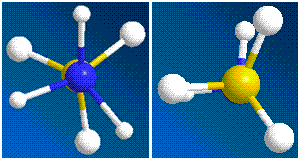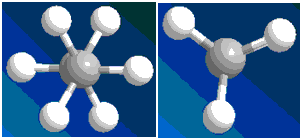Rep:Mod:tm79yb81ta83
Fuels of Future: Ammonia Borane
Introduction
Hydrogen is a suggested source of fuel in vehicle as it is a fairly “clean” fuel. However compressing the actual hydrogen gas into a container and using it can be problematic, so a solid compound such as ammonia borane with high hydrogen content is suggested. This compound is stable at room temperature and decomposes to give hydrogen.
NH4Cl + NaBH4 => NH3BH3 + H2 + NaCl
- in presence of THF with trace of NH3
Conformation
Ammonia borane (NH3BH3) has a structure analogous to ethane, therefore either staggered or eclipsed conformations are possible. Ethane adopts staggered conformation as it is lower in energy and borane behaves in a similar mannar.
| Conformation | Staggered | Eclipsed |
|---|---|---|
| Total energy (kcal/mol) | 14.4151 | 14.7119 |
| Bond length B-N (Å) | 1.508 | 1.511 |
| Bong length B-H (Å) | Cell B | Cell C |
| Bong length B-H (Å) | 1.055 | 1.048 |
| Bond length N-H (Å) | 1.352 | 1.354 |
| Dipole | -18.1064 | -17.7828 |
| Conformation | Staggered | Eclipsed |
|---|---|---|
| Total energy (kcal/mol) | 0.8179 | 3.5519 |
| Bond length C-C (Å) | 1.532 | 1.534 |
| Bong length C-H (Å) | 1.114 | 1.114 |
In the case of ethane difference in energy levels is quite significant whereas in the case of ammonia borane the difference is rather small so an equilibrium of these two conformers are likey to be placed in a such way that both confomers are likey to be present with but staggered conformer is slightly more abundant.
Ethane is a hydrocarbon purely consructed from carbon and hydrogen so there is no dipole present across the backbone of the structure. Therefore completely covalent however ammonia borane has a polarity through the B-N bond since boron is a more electronegative spieces compared to nitrogen.
Stability
From entropic point of view formation of amino borane is favoured due to evolution of H2 gas and strong sodium chlorine bond formation. Both reactants are ironic solid Na+.-BH4 and +NH4Cl- (primative cubic cell like structure). Sum of total energy of two molecules (when considered as anion) is 15.7818+88.2773 = 104.0591kcal/mol therefore even when you take ionic contribution into account products are more stable than the reactants.
References http://www.rsc.org/Publishing/ChemScience/Volume/2008/08/Borane_fuels.asp
David J. Heldebrant, Abhi Karkamkar, John C. Linehan and Tom Autrey, Energy Environ. Sci., 2008, 1, 156
Zhitao Xiong, Guotao Wu, Yong Shen Chua, Jianjiang Hu, Teng He, Weiliang Xu and Ping Chen, Energy Environ. Sci., 2008, 1, 360


